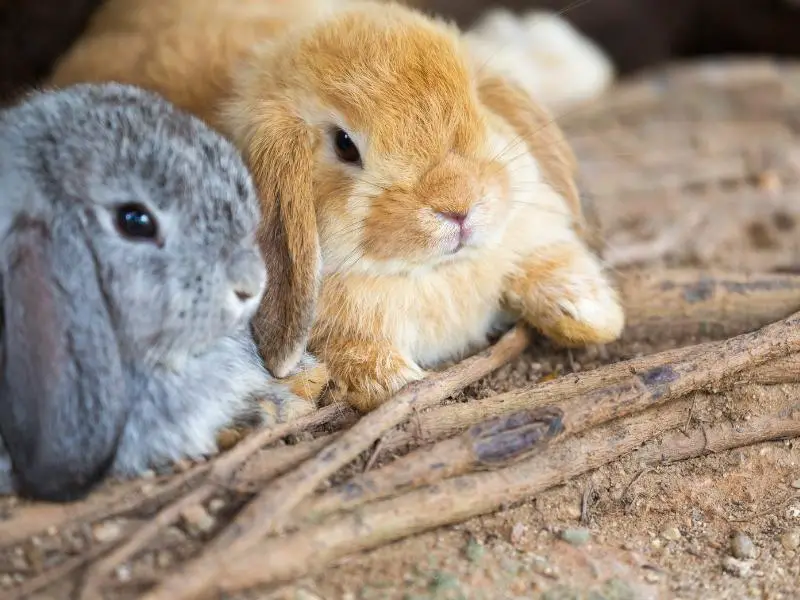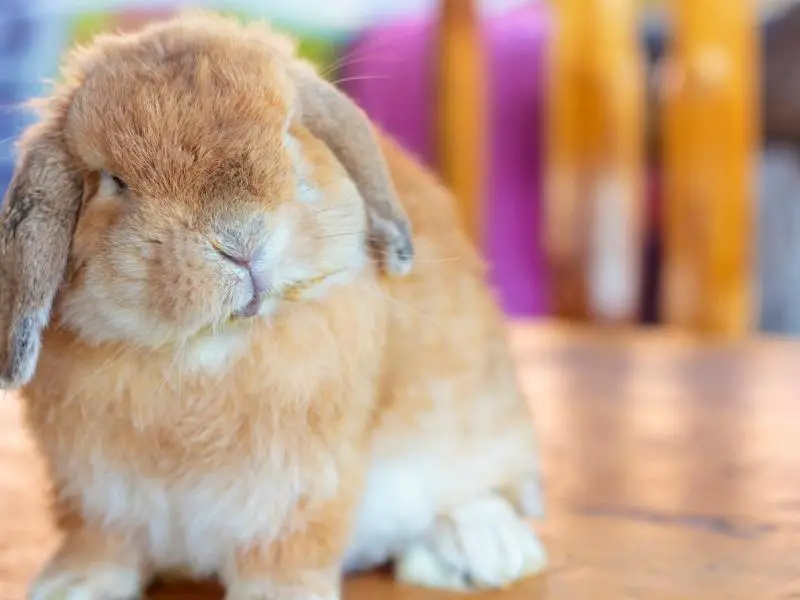Would you like one of the smallest lop rabbit breeds as a pet or a show rabbit? Why not consider the Miniature Lop rabbit, not to be confused with the Mini Lop or Holland Lop rabbit breeds. So what exactly is a Miniature Lop rabbit?
The Miniature Lop rabbit is a dwarf/small domestic rabbit breed the British Rabbit Council recognizes. An adult Miniature Lop weighs between 2.1 pounds to 3.5 pounds. A Miniature Lop rabbit has an average lifespan of 7 to 14 years; if well cared for, these bunnies can live for 18 years.
Ready to learn more about the UK Miniature Lop rabbit? Let’s examine how the Miniature Lop came to be, what the rabbit looks like, and if there are any special care considerations if you adopt a Miniature Lop.
What Is a Miniature Lop Rabbit?
Only the British Rabbit Council (BRC) recognizes the Miniature Lop rabbit, which is a dwarf-small rabbit breed commonly found in the United Kingdom.
Many people get confused with the name of this rabbit – Mini Lop is a shortened name of Miniature Lop in the UK – but a Mini Lop rabbit is a different rabbit breed that’s recognized by the American Rabbit Breeders Association (ARBA).
The American Mini Lop rabbit is NOT the same rabbit breed as the UK Miniature Lop rabbit because this rabbit breed has different origins.
In fact, the Miniature Lop is most similar – but again, NOT the same – as the Holland Lop rabbit that ARBA recognizes.
In this guide, we’ll only use the term Miniature Lop (UK, BRC-recognized) so there is no confusion.
Miniature Lop Rabbit History and Origin
As a relatively new rabbit breed, the Miniature Lop rabbit was bred from the first Dwarf Lops.
From late 1949 to the early 1950s, the Dwarf Lop rabbits were developed by the Holland Lop breed society, which comprised 12 rabbit breeders. The society, located in the Netherlands, was established by Adriann, a Dutch rabbit breeder and judge.
Adriann is credited with creating the Dwarf Lop rabbit breeds. He crossed a French Lop rabbit (which is one of the largest lop rabbits), with a Netherland Dwarf rabbit.
After more than a decade of careful selective breeding, in 1964, the Holland Lop rabbits that weighed between 4.4 to 5.5 pounds were first shown. This small lop rabbit breed became quite popular at the time.
Somewhere between 1965 and 1975, an English rabbit breeder with the name of George Scott learned about the Holland Lop rabbits. By 1975, these rabbits were imported to the United Kingdom, thanks to Scott.
Scott wanted the Holland Lop rabbit to be even smaller. He bred the lightest of the Holland Lops with each other, which created the Miniature Lop rabbit breed, or Mini Lop for short.
In 1994, the BRC recognized the Miniature Lop rabbit breed. The maximum weight of a Miniature Lop rabbit for shows, exhibitions, and competitions is 3.52 pounds.
For interest, the Mini Lop rabbit was created in Germany when a breeder crossbred a German Lop rabbit with a small Chinchilla rabbit. This new Mini Lop breed was called “Klein Widder,” which means little hanging ear.
The Mini Lop rabbit breed then made its way to the United States. In the 1970s, Bob Herschbach imported the first Mini Lops to the US, and then he started crossing them with a Standard Chinchilla rabbit.
“Klein Widder” rabbits became known as the Mini Lop rabbit breed, which ARBA accepted in the 1980s.
Miniature Lop Rabbit Characteristics

Since many people call the Miniature Lop rabbit a Mini Lop or Holland Lop rabbit, it’s essential to know exactly what a Miniature Lop bunny looks like.
Knowing what a rabbit’s personality is like – in general – helps you know if this rabbit breed is ideal for you.
Temperament
A Miniature Lop rabbit is friendly, good-natured, and very lively. They are well-known for their intelligence and playful personality.
If you have a Miniature Lop bunny, ensure the rabbit has plenty of physical and mental stimulation to keep them amused.
Give your bun plenty of attention, get them another rabbit to be friends with, and ensure there are lots of bunny-friendly toys for your Miniature Lop to play with.
If you don’t provide enough mental and physical stimulation for your rabbit, they will become bored, which can lead to aggressive behavior and/or depression.
If you adopt a kit, socialize them from an early age. Also, make sure to buy your bunny from a reputable breeder.
Body Shape
The Miniature Lop rabbit has a short, stocky body. They have strong and short legs and rounded haunches. Their head is broad and has a strong curved profile.
These bunnies have full cheeks, and their eyes are large and bold. There’s also the basal ridge that should be prominent on top of their heads to form their crown.
The Miniature Lop rabbit has lop-ears that are thick, broad, and rounded at the tips. Lop-ears are rabbit ears that hang down the side of a rabbit’s head.
To meet the BRC’s standards, the Miniature Lop’s inside ears shouldn’t be visible when they hang correctly.
Coat
The rollback coat of a Miniature Lop rabbit is dense with soft fur that’s medium in length.
Color Varieties
The Miniature Lop rabbit can have a fur coat that’s solid-colored (self-colored) or they can have white patches on their chest, head, and legs.
Here are the many color varieties of the Miniature Lop rabbit breed:
- Agouti
- Black
- Brown
- Blue
- Butterfly
- Chinchilla
- Fawn
- Fox
- Opal
- Orange
- Sable Marten
- Sealpoint
- Siamese sable
- Siamese smoke
- Sooty fawn
- Steel
- White
Miniature Lop Rabbit Care
If you are lucky enough to own a Miniature Lop rabbit or are considering adopting one, here are the care guidelines to follow to ensure your rabbit thrives:
Rabbit Enclosure
You can keep your Miniature Lop rabbit inside or outside.
The first aspect of a rabbit enclosure for your Miniature Lop is that the rabbit cage, pen, or hutch is big enough for your bun. Check out our guide on how big a rabbit enclosure should be.
Remember to attach an exercise pen to the rabbit enclosure so your active Miniature Lop can play and exercise as much as they want and need.
An outside hutch also needs to be reinforced so no predator can get in and eat your cute Miniature Lop. These hutches also need to be weather-proof to keep your bun protected from extreme weather.
If you keep your rabbit inside, rabbit-proof the rooms your bun has access to in your home so they don’t chew on your electrical cables, dig holes through your carpet, and more.
Plus, you also don’t want to come into your living room after getting some snacks to find that Ms. Fluffles electrocuted herself when she nibbled on your TV’s electrical cable, right?
Rabbit Food
A healthy and balanced diet contributes to growth, an increased life span, and several other benefits.
To ensure your rabbit eats healthily, give your rabbit high-quality hay to help them:
- wear down their teeth (which never stops growing and can cause various health issues if overgrown) and
- keep their digestive system working
Alfalfa hay is ideal for adolescent rabbits when they are growing and starting to eat hay.
Timothy hay is the best for adult rabbits unless your vet gives you other advice. Other kinds of hay you could consider for your adult Miniature Lop rabbit are ryegrass, march, bluegrass, herbal, meadow, oat, orchard, or fescue.
Your rabbit needs 70-80% of hay in your daily diet, so place the hay in a hay dispenser so your rabbit can nibble on the dried grass during the day.
Next, you want to feed your rabbit fresh leafy greens, herbs, and pellets twice a day at dusk and dawn – which is when these crepuscular mammals are most active.
A 2-pound rabbit needs 1 cup of leafy greens and herbs and 2 tablespoons of pellets, while a 3-pound Miniature Lop rabbit should eat 1.5 cups of these veggies a day and 3 tablespoons of pellets.
The pellets you feed your bun should have an 18% or higher fiber content, 12-14% protein content, and 3% or less fat content.
Your bun also needs clean drinking water every day, and then feed treats like carrots, apples, and bean sprouts sparingly. Give a 2-pound bunny 2 teaspoons or fewer treats, and a 3-pound Miniature Lop rabbit 1 tablespoon.
Rabbit Health
As far as rabbit health is concerned, regularly check in on your rabbit to make sure they are okay and healthy – especially if they live outside.
Take your bun for regular checkups with your vet, and ensure your rabbit’s teeth and nails don’t overgrow.
Also, keep an eye out for:
- Flystrike
- Sore hocks
- Digestive issues
- Hypothermia when it’s cold, windy, and/or rainy
- Hyperthermia when it is abnormally hot or there is a heatwave
- Ear mites
Breeding Miniature Lop Rabbit
The Miniature Lop rabbit is a small size rabbit so they aren’t bred for meat or fur. As such, the Miniature Lop bunny is bred to be petted for rabbit shows and competitions.
Miniature Lop Rabbit Price
The average price for a Miniature Lop rabbit is $26 dollars or £20.
My Last Bunny Thoughts
With the cuteness and winning personality of a Miniature Lop rabbit, you’ll surely want one of these bunnies after reading this guide on them.
Make sure to look after this small lop-eared bunny breed well and you’ll have a lop-eared fluffy bestie for a really, really, long time. Sounds amazing, right?

